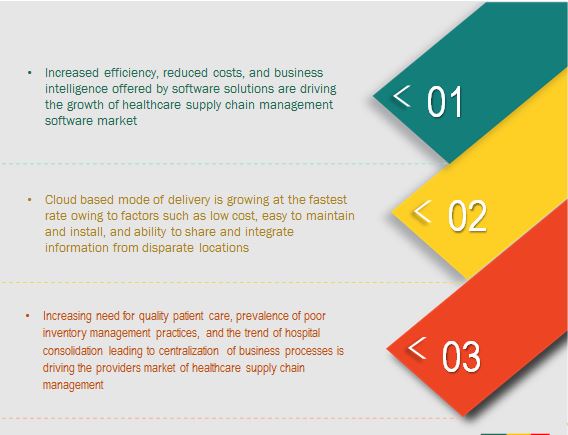MarketsandMarkets forecasts the Healthcare Supply Chain Management Market to grow from USD 3.3 billion by 2025 from USD 2.2 billion in 2020, at a CAGR of 7.9% during the forecast period. The key factors driving the growth of this market include the adoption of GS1 system of standard in the healthcare industry globally, the emergence of cloud-based solutions, reduction in operational costs by improving the efficacy and increase in overall profitability. However, the high cost of implementation of supply chain management software is expected to restrict market growth to a certain extent.
Increased adoption of software-based systems is expected to enhance the growth of the market
Healthcare supply chain management systems are available as two components, software, and hardware. A software system is highly acceptable compared to hardware systems due to the increasing number of online purchases, improving business intelligence, and growing preference for eco-friendly logistics. This is said to enhance the growth of the healthcare supply chain management market in the forecast period.
Download PDF Brochure @ https://www.marketsandmarkets.com/pdfdownloadNew.asp?id=77439622
The cloud-based segment will grow at the highest rate during the forecast period.
Based on delivery mode, the healthcare supply chain management market is segmented into on-premise and cloud-based. Though the on-premise segment holds the largest share in the market, the cloud-based segment is expected to register the highest growth over the forecast period. Cloud-based solutions help healthcare organizations share and integrate information from disparate locations; these solutions also offer minimum costs of installation and maintenance. Such advantages are driving market growth in this segment.
North America to account for the largest market size during the forecast period.
The healthcare supply chain management market is segmented into North America, Europe, the APAC, and the RoW. Of this, North America accounted for the largest share of the healthcare supply chain management industry in 2019. North America is a well-established and lucrative market for healthcare supply chain management.
In this regional market, the US is expected to offer potential growth opportunities to market players in the coming years. This can primarily be attributed to the consolidation of hospitals, rising prevalence of chronic diseases, and growing awareness in the country.
Key Market Players
SAP SE (Germany), Oracle Corporation (US), Infor (US), McKesson Corporation (US), TECSYS (US), Global Healthcare Exchange (US), Cardinal Health (US), Determine (US), Epicor (US), LLamasoft (US), Manhattan Associates (US), Blue Yonder Group, Inc. (JDA Software) (US), Cerner (US), Jump Technologies (US), LogiTag Systems (US), Harris Affinity (US), Premier (US), Accurate Info Soft (US), Hybrent (US), and Arvato Systems (Germany).
Oracle (US) is one of the prominent players in the healthcare supply chain management market. This leading position of the company can be attributed to its strong brand recognition and extensive product portfolio. The company has subsidiaries spread across Europe, the Middle East, Africa, Asia Pacific, North America, and South America. The company focuses on product enhancements as a part of its growth strategy. In 2019, Oracle Corporation enhanced its Oracle Cloud offerings with the addition of new features to its cloud applications, which includes tools like supply chain management, enterprise resource planning (ERP), human capital management (HCM), and customer experience (CX). These solutions enable end-users to accelerate business performance and increase productivity.
Request for Sample Pages @ https://www.marketsandmarkets.com/requestsampleNew.asp?id=77439622
Recent Developments
• In 2020, Infor acquired Intelligent InSite.
• In 2019, Oracle launched Intelligent Track and Trace, a blockchain application
• In 2019, SAP SE partnered with Microsoft Corporation, to improve consumer adoption of SAP Cloud Platform and SAP S/4 HANA on Microsoft Azure.
Critical questions the report answers:
• How will the current technological trends affect the healthcare supply chain management market in the long term?
• What are the reasons contributing to the growth of the software segment in the healthcare supply chain management market?
• Which regions are likely to grow at the highest CAGR?
• What are the challenges hindering the adoption of digital pathology solutions?
• What are the growth strategies being implemented by major market players?
Home Health and Wellness Healthcare Supply Chain Management Market worth $3.3 billion by 2025 – Exclusive...





